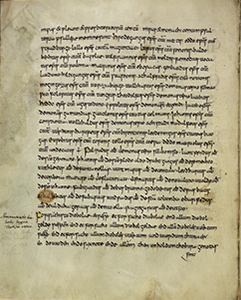Altsächsisch – multimedial

As far as we know today, 23 smaller prose and verse texts in Old Saxon have been transmitted from the 9th to the end of the 12th century. But in none of the previous editions have all the texts been included. The last, now largely outdated edition with a critical apparatus, annotations, and glossary was published by Elis Wadstein in 1899; individual texts were also included in Elias von Steinmeyer's edition of 1916. Since then, however, not only have edition standards changed and developed, but additional text witnesses have also been discovered that are not yet included in Wadstein 1899 and von Steinmeyer 1916. On the basis of the outlined state of research, access to the smaller Old Saxon texts as a coherent corpus, presented according to modern requirements, is therefore not possible at the present time. The project ‘Altsächsisch multimedial’ aims to fundamentally resurvey the subject area in a methodically innovative combination of digital processing and ‘classical’ philological tools: In an online portal, the text corpus will be made newly accessible in cooperation with Heidelberg University Library in transcriptions and editions with apparatuses pertaining to palaeography and codicology, textual criticism and the history of research and editions, as well as in high-quality colour digitisations of the entire textual tradition. All Old Saxon texts are additionally made accessible in New High German, English, and Italian translations, as well as – for the first time ever – presented as professionally voiced audio recordings. In addition, an introduction and a commentary present the content of each text in line with the current state of research and provide insight into the text. As a complement to the online presentation, ‘Altsächsisch multimedial’ will publish the edited text corpus as a book (print edition and e-book as open access). The earliest evidence of vernacular culture in Low German from the Carolingian, Ottonian, and Salian periods is thus made available for research and teaching in accordance with current standards, well beyond the narrower circle of early medieval German studies.
